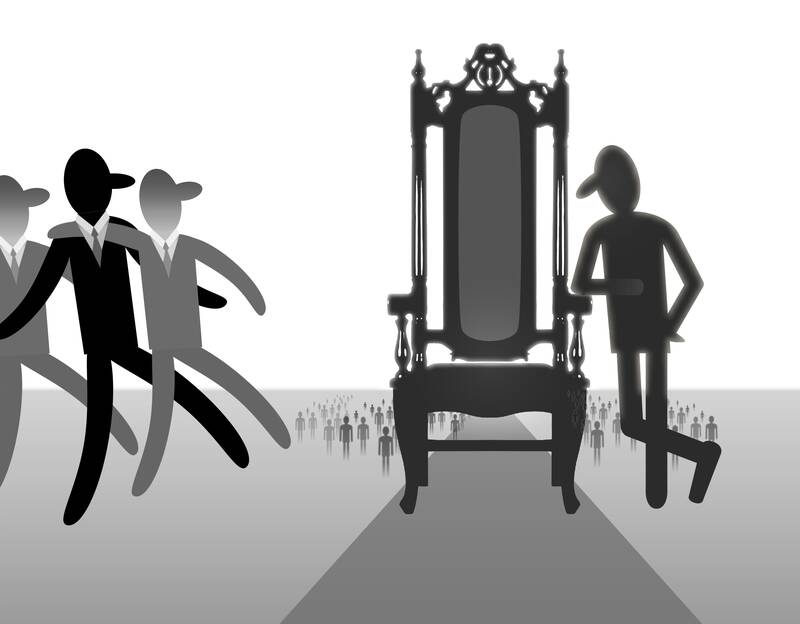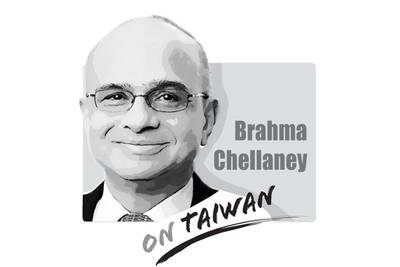In the twilight of his political career, US President Joe Biden is disappearing into the background even before US president-elect Donald Trump returns to the White House, despite growing turmoil at home and abroad.
The 82-year-old US president’s silence on a looming government shutdown over Christmas is just the latest example of how critics say the aging leader is in office, but not in power.
Despite still occupying the world’s most powerful pulpit, Biden has remained virtually absent from the public debate about his noisy successor, whom he often used to brand as a threat to democracy.

Illustration: Mountain People
While Biden stays largely off the radar, it is Trump who increasingly calls the shots, whether by carrying out his own shadow foreign policy or by torpedoing a deal to fund the government.
“This is a Biden problem to solve!” Trump said on his TruthSocial network on Friday.
Biden did make a public appearance on Friday at the Children’s National Hospital in Washington, but did not address the shutdown threat — instead playing a game of catch with an energetic toddler.
Under intense questioning on Friday, the White House defended Biden’s silence on the stand-off with Republicans.
“They blew it up, and they need to fix it. This is not for the president to fix,” White House Press Secretary Karine Jean-Pierre told reporters.
It was always going to be a painful exit for Biden, after he was forced to drop out of the election in June following a disastrous debate against Trump.
He handed over the Democratic nomination to US Vice President Kamala Harris yet was widely reported to have believed that he could have succeeded where she failed against the Republican.
The White House insists that Biden is in what White House Chief of Staff Jeff Zients called a “sprint to the finish line” to preserve his legacy before the Jan. 20 handover of power. In recent weeks he has unveiled a string of last-gasp efforts to “Trump-proof” policies on everything from student loan forgiveness to the economy.
He gave televised speeches to hail a ceasefire in Lebanon and to claim credit for the fall of former Syrian president Bashar al-Assad — while his administration is still pushing for a truce in Gaza.
Yet sometimes his efforts have often underscored how the US’ oldest president is fading away more than going out with a bang.
Biden coughed throughout what was meant to be a showpiece speech to trumpet his economic legacy last week.
He also appeared frail in a trip to the Amazon during which he momentarily looked like he was wandering off into the jungle, and missed a group photo with G20 leaders in Brazil when they refused to wait for him.
In Angola, making a long-promised first trip of his president to sub-Saharan Africa, Biden appeared to be resting his eyes for several periods during a summit.
Moreover, the man who was once one of the most garrulous politicians in Washington has been almost silent in the face of reporters’ questions.
Biden has in particular declined to say whether he still believes Trump remains a threat to democracy, despite repeatedly condemning the Republican during the campaign for his actions during the Jan. 6, 2021 attack on the US Capitol.
He has also refused to comment on perhaps his most prominent act since the election defeat, a pardon for his troubled son Hunter Biden on gun and tax charges.
The sense of a Biden fade-out has not been helped by a proliferation of stories in US media about his decline.
The Wall Street Journal reported last week that White House gatekeepers built a wall around a “diminished” Biden during his presidency, keeping meetings short and controlling access.
The White House denied that Biden had declined physically or mentally, it said.
David Karol, who teaches government and politics at the University of Maryland, said that on the shutdown Democrats had “made the political calculation that it is best to leave the spotlight to Trump and [close ally] Elon Musk.”
Trump “really never went away. By contrast, Biden has been the quietest president in decades,” Karol said.

Donald Trump’s return to the White House has offered Taiwan a paradoxical mix of reassurance and risk. Trump’s visceral hostility toward China could reinforce deterrence in the Taiwan Strait. Yet his disdain for alliances and penchant for transactional bargaining threaten to erode what Taiwan needs most: a reliable US commitment. Taiwan’s security depends less on US power than on US reliability, but Trump is undermining the latter. Deterrence without credibility is a hollow shield. Trump’s China policy in his second term has oscillated wildly between confrontation and conciliation. One day, he threatens Beijing with “massive” tariffs and calls China America’s “greatest geopolitical
On Sunday, 13 new urgent care centers (UCC) officially began operations across the six special municipalities. The purpose of the centers — which are open from 8am to midnight on Sundays and national holidays — is to reduce congestion in hospital emergency rooms, especially during the nine-day Lunar New Year holiday next year. It remains to be seen how effective these centers would be. For one, it is difficult for people to judge for themselves whether their condition warrants visiting a major hospital or a UCC — long-term public education and health promotions are necessary. Second, many emergency departments acknowledge
US President Donald Trump’s seemingly throwaway “Taiwan is Taiwan” statement has been appearing in headlines all over the media. Although it appears to have been made in passing, the comment nevertheless reveals something about Trump’s views and his understanding of Taiwan’s situation. In line with the Taiwan Relations Act, the US and Taiwan enjoy unofficial, but close economic, cultural and national defense ties. They lack official diplomatic relations, but maintain a partnership based on shared democratic values and strategic alignment. Excluding China, Taiwan maintains a level of diplomatic relations, official or otherwise, with many nations worldwide. It can be said that
Chinese Nationalist Party (KMT) Chairwoman Cheng Li-wun (鄭麗文) made the astonishing assertion during an interview with Germany’s Deutsche Welle, published on Friday last week, that Russian President Vladimir Putin is not a dictator. She also essentially absolved Putin of blame for initiating the war in Ukraine. Commentators have since listed the reasons that Cheng’s assertion was not only absurd, but bordered on dangerous. Her claim is certainly absurd to the extent that there is no need to discuss the substance of it: It would be far more useful to assess what drove her to make the point and stick so